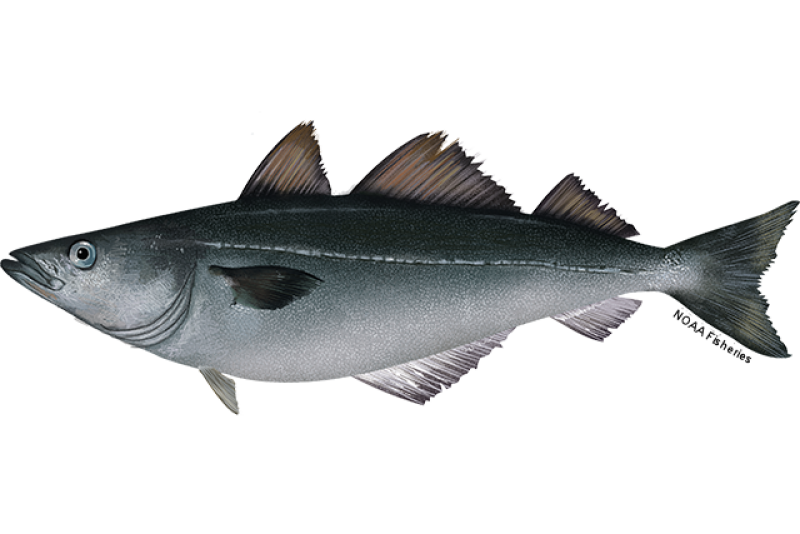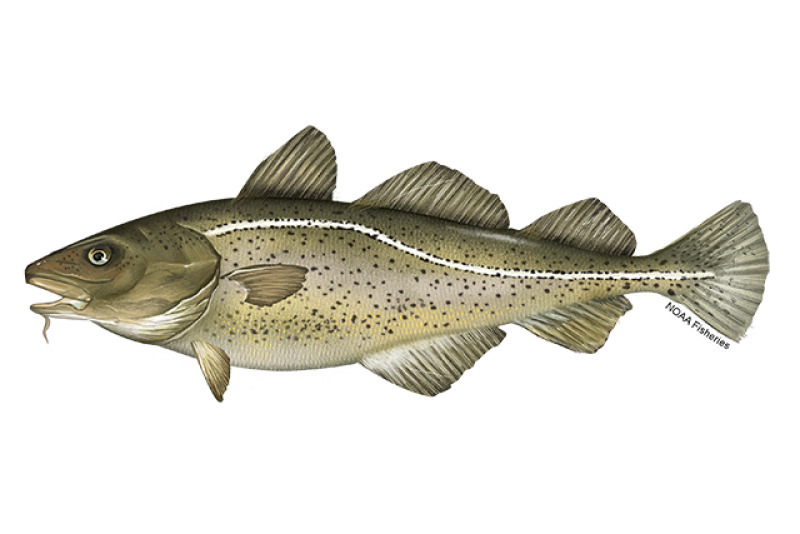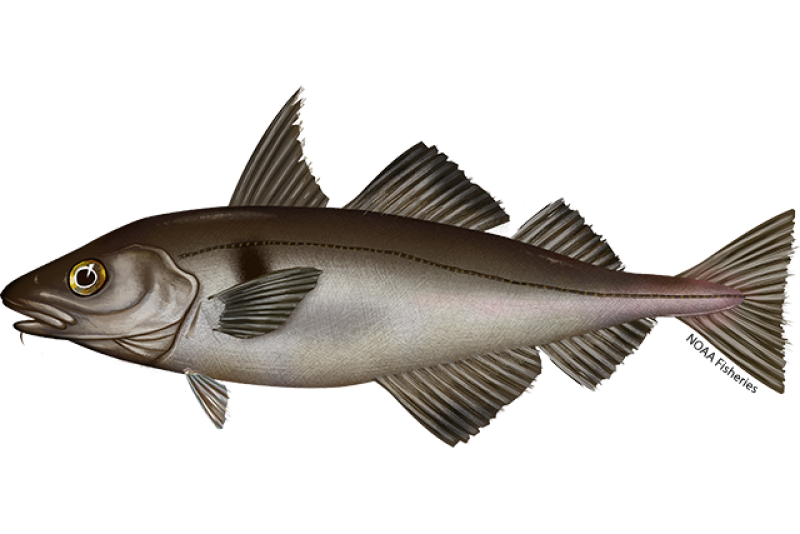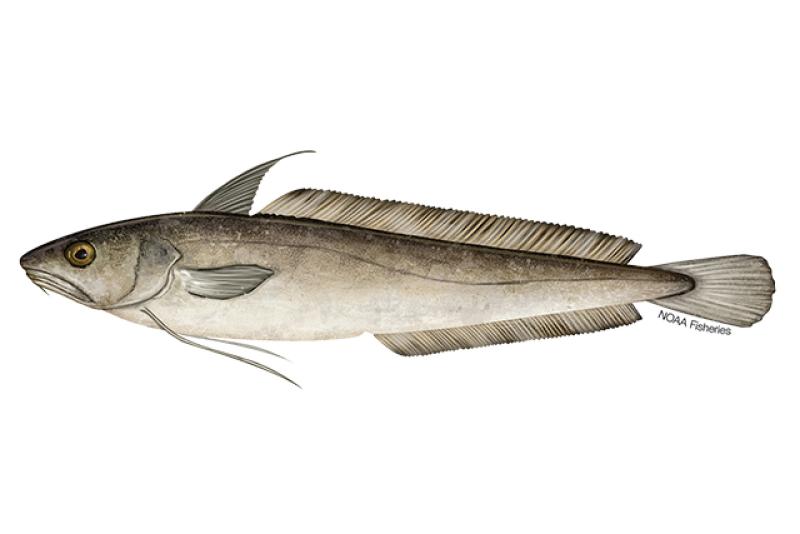About the Species
U.S. wild-caught Atlantic pollock is a smart seafood choice because it is sustainably managed and responsibly harvested under U.S. regulations.

Population
The stock is not overfished.

Fishing Rate
Not subject to overfishing.

Habitat Impact
Area closures and gear restrictions protect habitat that are affected by some kinds of trawl gear.

Bycatch
Regulations are in place to minimize bycatch.
Population Status
- According to the 2024 stock assessment, Atlantic pollock is not overfished and is not subject to overfishing. Summary stock assessment information can be found on Stock SMART.
Appearance
- Atlantic pollock are brownish-green on the back and slightly pale on the belly.
- They have a small chin barbel, like the whiskers on a catfish.
- They are a member of the cod family but can be distinguished by their greenish hue and darker flesh.
Biology
- Atlantic pollock grow fast at first until they sexually mature between the ages of 3 and 6.
- They grow to more than 3 ½ feet long and 35 pounds and can live a long time, up to 23 years.
- Atlantic pollock spawn from November through February over hard, stony, or rocky ocean bottoms in areas throughout the Gulf of Maine and Georges Bank.
- They spawn multiple times per season.
- Pollock eggs rise into the water column after they are released and fertilized.
- Smaller pollock in inshore waters feed on small crustaceans and small fish. Larger pollock mainly prey on fish.
- A variety of fish eat juvenile pollock. Spiny dogfish, monkfish, and other pollock prey on adults.
Where They Live
Range
- Atlantic pollock are found in the Northwest Atlantic Ocean and are most common on the western Scotian Shelf and in the Gulf of Maine.
Habitat
- Pollock eggs and larvae are found in the water column.
- Juveniles are found inshore and move offshore as they grow older. When in inshore waters, juvenile pollock school in the open water at low tide, then scatter at high tide and hide in intertidal seaweed beds.
- Adults live offshore near the ocean floor over a wide variety of ocean bottom habitats including sand, mud, rocks, and vegetation.
- Atlantic pollock swim in schools and are believed to travel extensively between the Scotian Shelf and Georges Bank and, to a lesser extent, between the Scotian Shelf and the Gulf of Maine.
Fishery Management
- NOAA Fisheries and the New England Fishery Management Council manage the fishery.
- Pollock, along with other groundfish in New England waters, are managed under the Northeast Multispecies Fishery Management Plan, which includes:
- Permitting requirements for commercial vessels.
- Separate management measures for recreational vessels.
- Time/Area Closures to protect spawning fish and habitat.
- Minimum fish sizes to prevent harvest of juvenile fish.
- Annual catch limits, based on best available science.
- An optional sector (catch share) program can be used for cod and other groundfish species. The sector program allows fishermen to form harvesting cooperatives and work together to decide when, where, and how they harvest fish.
Harvest
Commercial fishery:
- In 2023, commercial landings of Atlantic pollock totaled approximately 7.5 million pounds and were valued at $8.8 million, according to the NOAA Fisheries commercial fishing landings database.
Gear types, habitat impacts, and bycatch:
- Pollock are commonly harvested using trawl nets, gillnets, bottom longlines, and rod and reel.
- Gillnets, longlines, and rod and reel used to harvest pollock have little to no impact on habitat.
- Areas closures and gear restrictions reduce habitat impacts from trawl nets.
- Fishermen follow management measures to designed to reduce interactions with marine mammals, including gear modifications, seasonal closures, and use of marine mammal deterrents.
- Recreational fishery:
- Pollock is growing in popularity with anglers that have traditionally targeted other groundfish like cod and haddock. Anglers target pollock from boats and shore using both lures and bait. Successful anglers find that the fish puts up a spirited fight. Fishing occurs year-round.
- Regulations are limited to a minimum fish size in federal waters.
Scientific Classification
- Atlantic pollock are found in the Northwest Atlantic Ocean and are most common on the western Scotian Shelf and in the Gulf of Maine.
- Pollock eggs and larvae are found in the water column.
- Juveniles are found inshore and move offshore as they grow older. When in inshore waters, juvenile pollock school in the open water at low tide, then scatter at high tide and hide in intertidal seaweed beds.
- Adults live offshore near the ocean floor over a wide variety of ocean bottom habitats including sand, mud, rocks, and vegetation.
- Atlantic pollock swim in schools and are believed to travel extensively between the Scotian Shelf and Georges Bank and, to a lesser extent, between the Scotian Shelf and the Gulf of Maine.
Fishery Management
- NOAA Fisheries and the New England Fishery Management Council manage the fishery.
- Pollock, along with other groundfish in New England waters, are managed under the Northeast Multispecies Fishery Management Plan, which includes:
- Permitting requirements for commercial vessels.
- Separate management measures for recreational vessels.
- Time/Area Closures to protect spawning fish and habitat.
- Minimum fish sizes to prevent harvest of juvenile fish.
- Annual catch limits, based on best available science.
- An optional sector (catch share) program can be used for cod and other groundfish species. The sector program allows fishermen to form harvesting cooperatives and work together to decide when, where, and how they harvest fish.
Harvest
Commercial fishery:
- In 2023, commercial landings of Atlantic pollock totaled approximately 7.5 million pounds and were valued at $8.8 million, according to the NOAA Fisheries commercial fishing landings database.
Gear types, habitat impacts, and bycatch:
- Pollock are commonly harvested using trawl nets, gillnets, bottom longlines, and rod and reel.
- Gillnets, longlines, and rod and reel used to harvest pollock have little to no impact on habitat.
- Areas closures and gear restrictions reduce habitat impacts from trawl nets.
- Fishermen follow management measures to designed to reduce interactions with marine mammals, including gear modifications, seasonal closures, and use of marine mammal deterrents.
- Recreational fishery:
- Pollock is growing in popularity with anglers that have traditionally targeted other groundfish like cod and haddock. Anglers target pollock from boats and shore using both lures and bait. Successful anglers find that the fish puts up a spirited fight. Fishing occurs year-round.
- Regulations are limited to a minimum fish size in federal waters.
Scientific Classification
| Kingdom | Animalia | Phylum | Chordata | Class | Actinopterygii | Order | Gadiformes | Family | Gadidae | Genus | Pollachius | Species | virens |
|---|
Last updated by NOAA Fisheries on 03/20/2025
Featured News
 The NOAA research vessel Gloria Michelle conducts groundfish surveys in New England, an important mission to support science-based fisheries management. Photo credit: NOAA Fisheries
The NOAA research vessel Gloria Michelle conducts groundfish surveys in New England, an important mission to support science-based fisheries management. Photo credit: NOAA Fisheries
As Fishing Season Opens, NOAA Implements Emergency Action to Ensure Uninterrupted Northeast Fisheries
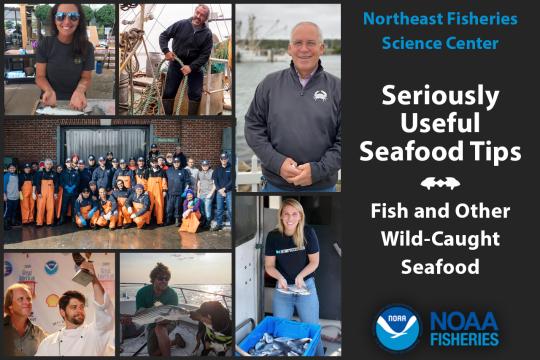
Seriously Useful Seafood Tips: Fish and Other Wild-Caught Seafood
 Chef Rob's Pulled Opah Sandwich. Credit: Sam Wells.
Chef Rob's Pulled Opah Sandwich. Credit: Sam Wells.
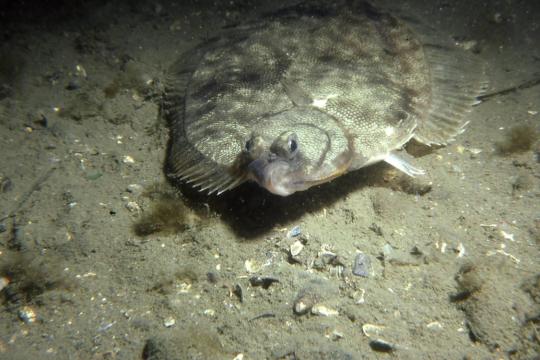 Winter flounder (Pseudopleuronectes americanus) in Narragansett Bay. It is a flatfish native to coastal waters of the western North Atlantic coast from Labrador to Georgia, although it is less common south of Delaware Bay. It feeds on bottom-dwelling animals. Photo: NOAA Fisheries
Winter flounder (Pseudopleuronectes americanus) in Narragansett Bay. It is a flatfish native to coastal waters of the western North Atlantic coast from Labrador to Georgia, although it is less common south of Delaware Bay. It feeds on bottom-dwelling animals. Photo: NOAA Fisheries
Predator-Prey Interaction Study Reveals More Food Does Not Always Mean More Consumption
Seafood Facts

Is Atlantic Pollock Sustainable?
U.S. wild-caught Atlantic pollock is a smart seafood choice because it is sustainably managed and responsibly harvested under U.S. regulations.
Availability
Year-round. Peak landings are from November through January.
Source
U.S. wild-caught from Maine to Virginia.
Taste
Sweet and delicate.
Texture
Firm.
Color
White.
Health Benefits
Atlantic pollock is very low in saturated fat and is a very good source of protein, vitamin B12, phosphorus, and selenium.
Nutrition Facts
Servings: 1; Serving Weight: 100 g (raw); Calories: 92; Protein: 19.44 g; Total Fat: 0.98 g; Total Saturated Fatty Acids: 0.135 g; Carbohydrate: 0 g; Total Sugars: 0 g; Total Dietary Fiber: 0 g; Cholesterol: 71 mg; Selenium: 36.5 mcg; Sodium: 86 mgPollock Recipes
Looking for some ways to add pollock into your rotation? If you need cooking inspiration, browse these recipes for creamy pollock enchiladas, pollock street tacos, and more!

Last updated by NOAA Fisheries on 03/20/2025
Seafood News
 Celebrate Culinary Arts Month with a sustainable seafood recipe for every month of the year.
Celebrate Culinary Arts Month with a sustainable seafood recipe for every month of the year.
What Your Birth Month Says About Your Next Seafood Recipe
 Fresh-caught taʻape on ice. Credit: Conservation International Hawaiʻi.
Fresh-caught taʻape on ice. Credit: Conservation International Hawaiʻi.
Reducing Waste and Feeding Communities in Hawaiʻi with a Whole Fish Approach
 Chef Tyler Hadfield’s Curried Skate Wings with Tomato-Masala Chutney
Chef Tyler Hadfield’s Curried Skate Wings with Tomato-Masala Chutney
Ring In the New Year With These Crowd-Favorite Seafood Recipes
 NOAA Fisheries, in collaboration with Blue Ocean Mariculture, is conducting a multi-year pilot study to evaluate observational methods and tools for studying Hawaiian monk seal behavior. Courtesy of Blue Ocean Mariculture
NOAA Fisheries, in collaboration with Blue Ocean Mariculture, is conducting a multi-year pilot study to evaluate observational methods and tools for studying Hawaiian monk seal behavior. Courtesy of Blue Ocean Mariculture
AI Meets Aquaculture to Study Hawaiian Monk Seal Interactions With Net Pens
Management Overview
Atlantic pollock is managed under the Northeast Multispecies (Groundfish) Fishery Management Plan (FMP) along with 12 other species of groundfish. Collectively, these 13 species are referred to as the Northeast multispecies complex.
Learn more about the Northeast multispecies complex and its management
Last updated by NOAA Fisheries on 03/20/2025
Documents
Age Determination Methods for Northwest Atlantic Species
This manual documents age determination techniques used by staff at the Woods Hole Laboratory to…
Last updated by NOAA Fisheries on 03/20/2025
